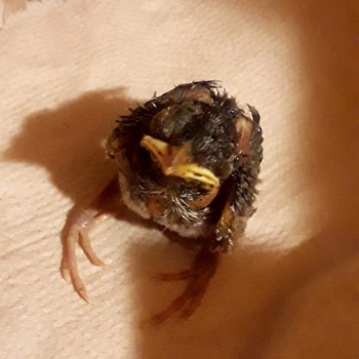
No parent came for the little squawker. I scooped him up, we headed home. From numerous animal care seminars, I knew to keep him dark, safe and warm. Punched holes in shoebox, filled water bottle with warm water, lined box with paper towels and added bird. Placed box in quiet laundry room, allowing him to settle. Left message at wildlife center requesting assistance from licensed rehabber. She determined the age and instructed me to soak a couple cat food kibbles (higher in protein than dog food) in warm water and feed with a tweezer, every three hours. Keep him quiet, warm, dark, and safe (and best of all) drop him off to her in the morning.
A friend got an adorable new puppy, and shared video. After a joyful burst of running and playing, she bounced to her ice-filled bowl.
A nice lady recently found a small blind field mouse. She brought him home, and offered him dairy milk, cheese and a cracker.
Another friend posted feeding a wild iguana and a bunny scraps of white bread, which they gobbled up. “It’s like crack to them!” he said.
One of the first things taught in any animal care workshop/class is the importance of creating a safe environment and diet as close to what an animal would encounter in its natural setting.
Keeping the mockingbird warm, dark and safe mimicked his nest. A high protein diet like his parents provided helped ensure his survival.
Expert care by a licensed rehabber, with the intention of keeping him wild and releasing him to the life he was born to, priceless.
Unless a dog lives in the Arctic, how would they develop a taste for icy cold water? A cube or two on a hot day is fine. Filling their bowl with ice serves no purpose, and can be dangerous. Cold constricts blood vessels, narrowing the passage of blood. Dogs may drink more water than they need, as the cold masks their ability to feel quenched, and can lead to bloat. Even for humans, room temperature water assimilates to our bodies best.
Offer a child unlimited candy.
They will eat it until they feel ill, because it tastes so good and is readily available.
Where would a wild mouse find milk, cheese or a cracker? A cracker may be close to the mouse’s healthy diet. Milk and cheese are not natural items, and could result in stomach upset, smelly mess, and possible death. I recall a family bringing home a fawn whose mother had been killed by a car. Weeks later, they brought Bambi to the wildlife center. “Loves cheddar cheese and chocolate milk from a bottle”, on the intake form. Her condition was listed as “failure to thrive”. Days later, she died.
Wildlife should not ingest milk from another mammal, processed/ baked products laden with sugar, stripped of nutrients. Will they eat it? Heck yea, because it’s offered, easy and tastes good. By feeding wildlife, you decrease their fear of humans/cars, and they become dependant on unhealthy handouts.
Iguanas and rabbits dine on greens readily available in our lush Florida tropical land scape, supplemented by fresh veggies and fruit. Domestic rabbits do well on a diet of alfalfa and specially formulated pellets, seeds, nuts and fresh offerings.
Be mindful what you offer your cat or dog. Read labels, make the best choices you can. Avoid anything with corn, wheat, soy or by-products, which are just cheap fillers with long shelf lives.
All of the people above thought they were doing the right things. If you want to be a real friend to all animals, implement the tried and true rule: Follow nature’s example.






















